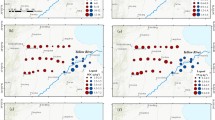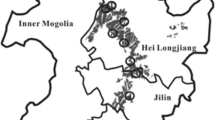Abstract
As a safe, stable and practical labeling method, the natural abundance of 13C has been widely used in a carbon cycle in the soil-plant system. In order to understand the effects of maize growth and photosynthesis on the value of δ13C in soil respiration, the value of δ13C in soil respiration was determined by mass spectrum after being trapped in a NaOH solution under a closed static chamber and then turned into barium carbonate in a pot experiment. The results showed that maize growth and photosynthesis significantly affected the value of δ13C in the soil respiration. In maize-planted soil, the value of δ13C in soil respiration had a clear seasonal variation. It changed with maize growth in the range of −14.57‰ to −12.3‰ and decreased during the period of trumpeting > ripening > flowering stages. The difference of δ13C in soil respiration during various maize growth stages added up to about 2.3‰ However, in bare soil, δ13C in soil respiration ranged from −19.34‰ to −19.13‰ and did not change significantly over time. The δ13C in soil respiration in the maize-planted soil was the lowest at flowering stage. This was mainly due to the decline of the input in assimilates into soil and the decrease in root activity. However, the δ13C increased at ripening stage, due to the decomposition and ingestion of senescent and died roots by soil microorganisms. In the planted soil, δ13C in soil respiration was significantly higher during daytime than at nighttime at flowering and ripening stages. The difference of δ13C in soil respiration between day and night periods added up to about 1.4‰ and 2.1‰ at flowering and ripening stages, respectively. Shading maize plants at the trumpeting stage decreased the value of δ13C in soil respiration significantly. The difference of δ13C in soil respiration between the treatment of non-shading and shading plants added up to 2.85‰ It was concluded that δ13C in soil respiration was remarkably controlled by the maize growth and photosynthesis in planted soil. Soil respiration was mainly derived from the recent assimilates during maize growth.
Similar content being viewed by others
References
Andrews J A, Matamala R, Westover K M, Schlesinger W H (2000). Temperature effects on the diversity of soil heterotrophs and the δ13C of soil-respired CO2. Soil Biol & Biochem, 32: 699–706
Balesdent J, Mariotti A, Guillet B (1987). Natural 13C abundance as a tracer for studies of soil organic matter dynamics. Soil Biol & Biochem, 19: 25–30
Bond-Lamberty B, Wang C, Gower S T (2004). Contribution of root respiration to soil surface CO2 flux in a boreal black spruce chronosequence. Tree Physiology, 24: 1387–1395
Chen X L, Zhang J H (1994). The investigation on senescences of leaves and roots in maize. Journal of Laiyang Agricultural College, 11(1): 17–20 (in Chinese)
Cheng S Y, Zhang X Z (2003). A review on differential methods for root and soil microbial contributions to total soil respiration. Advance in Earth Sciences, 18(4): 597–602 (in Chinese)
Cheng W (1996). Measurement of rhizosphere respiration and organic matter decomposition using natural 13C. Plant and Soil, 183: 263–268
Cheng W, Coleman D C, Carroll C R, Hoffman C A (1993). In situ measurement of root respiration and soluble C concentrations in the rhizosphere. Soil Biol & Biochem, 25(9): 1189–1196
Cheng W, Coleman D C, Carroll C R, Hoffman C A (1994). Investigating short-term carbon flows the rhizospheres of different plant species, using isotopic tracing. Agron J, 86: 782–788
Craine J M, Wedin D A, Chapin F S (1999). Predominance of ecophysiological controls on soil CO2 flux in a Minnesota grassland. Plant and Soil, 207: 77–86
Domanski G, Kuzyakov Y, Siniakina S V, Stahr K (2001). Carbon flows in the rhizosphere of ryegrass (Lolium perenne). J Plant Nutr Soil Sci, 164: 381–387
Dou S, Zhang J J (2001). Introduction of a method for studying turnover of soil organic matter. Journal of Jilin Agricultural University, 23(2): 64–67 (in Chinese)
Ekblad A, Högberg P (2001). Nature aboundance of 13C in CO2 respired from forest soils reveals speed of link between tree photosynthesis and root respiration. Oecologia, 127: 305–308
Fu S, Cheng W, Susfalk R (2002). Rhizosphere respiration varies with plant species and phenology: A greenhouse pot experiment. Plant and Soil, 239: 133–140
Gregory P J, Atwell B J (1991). The fate of carbon in pulse-labelled crops of barley and wheat. Plant and Soil, 136: 205–213
Illeris L, Michelsen A, Jonasson S (2003). Soil plus root respiration and microbial biomass following water, nitrogen, and phosphorus application at a high arctic semi desert. Biogeochemistry, 85: 15–29
Johansson G (1993). Carbon distribution in grass (Festuca pratensis L.) during regrowth after cutting—utilization of stored and newly assimilated carbon. Plant and soil, 151: 11–20
Kelting D L, Burger J A, Edwards G S (1998). Estimating root respiration, microbial respiration in the rhizosphere, and root-free soil respiration in forest soils. Soil Biol & Biochem, 30: 961–968
Kristiansen S M, Brandt M, Hansen E M, Magid J, Christensen B T (2004). 13C signature of CO2 evolved from incubated maize-derived sheep faces. Soil Biol & Biochem, 36: 99–105
Kuzyakov Y (2002). Review: Factors affecting rhizosphere priming effects. J Plant Nutr Soil Sci, 165: 382–396
Kuzyakov Y, Biryukova O V, Kuznetzava T V, Mölter k, Kandeler E, Stahr K (2002). Carbon partitioning in plant and soil, carbon dioxide fluxes and enzyme activities as affected by cutting ryegrass. Bio Fertil Soils, 35: 348–358
Kuzyakov Y, Cheng W (2004). Photosynthesis controls of CO2 efflux from maize rhizosphere. Plant and Soil, 263: 85–99
Kuzyakov Y, Ehrensberger H, Stahr K (2001). Carbon partitioning and below-ground translocation by Loliun perenne. Soil Biol & Biochem, 33: 61–67
Kuzyakov Y, Kretzschmar A, Stahr K (1999). Contribution of Lolium perenne rhizodeposition to carbon turnover of pasture soil. Plant and Soil, 213: 127–136
Lee M, Nakane K, Nakatsubo T, Koizumi H (2003). Seasonal changes in the contribution of root respiration to total soil respiration in a cool-temperate deciduous forest. Plant and Soil, 255: 311–318
Meharg A A, Killham K (1990). Carbon distribution within the plant and rhizosphere in laboratory and field-grown Lolium perenne at different stages of development. Soil Biol & Biochem, 22: 471–477
Nyberg G, Ekblad A, Buresh R, Högberg P (2000). Respiration from C3 plant green manture added to a C4 plant carbon dominated soil. Plant and Soil, 218: 83–89
Olsrud M, Christensen T R (2004). Carbon cycling in subarctic tundra, seasonal variation in ecosystem partitioning based on in situ 14C pulse-labelling. Soil Biol & Biochem, 36: 245–253
Pan R C (2004). Plant Physiology. (5th ed). Beijing: Higher Education Press, 229–230 (in Chinese)
Rochette P, Flanagan L B (1997). Quantifying rhizosphere respiration in a corn crop under field conditions. Soil Sci Soc Am J, 61: 466–474
Rochette P, Flanagan L B, Gregorich E G (1999). Separating soil respiration into plant and soil components using analyses of the natural abundance of carbon-13. Soil Sci Soc Am J, 63: 1207–1213
Saggar S, Hedley C, Mackay A D (1997). Partitioning and translocation of photosynthetically fixed 14C in grazed hill pastures. Biol Fertil Soils, 25: 152–158
Schlesinger W H, Andrews J A (2000). Soil respiration and the global carbon cycle. Biogeochemistry, 48: 7–20
Swinnen J, Van Veen J A, Merckx R (1994). 14C pulse-labeling of field-grown spring wheat: An evaluation of its use in rhizosphere carbon budget estimations. Soil Biol & Biochem, 26: 161–170
Wang W J (1998). Crop Cultivation. Beijing: Scientific Technology and Literature Press, 165 (in Chinese)
Warembourg F R, Esterlrich H D (2001). Plant phenology and soil fertility effects on below-ground carbon allocation for an annual (Bromus madritensis) and a perennial (Bromus erectus) grass species. Soil Biol & Biochem, 33: 1,291–1,303
Yang L, Cai Z (2005). The effect of growing soybean (Glycine max L.) on N2O emission from soil. Soil Biol & Biochem, 37: 1205–1209
Zhang D Q, Shi P L, Zhang X Z (2005). Some advance in the main factors controlling soil respiration. Advances in Earth Sciences, 20(7): 778–785 (in Chinese)
Author information
Authors and Affiliations
Corresponding author
Additional information
__________
Translated from Acta Ecologica Sinica, 2007, 27(3): 1072–1078 [译自: 生态学报]
About this article
Cite this article
Yang, L., Cai, Z. & Qi, S. Effects of maize (Zea mays L.) growth and photosynthesis on δ13C in soil respiration. Front. Agric. China 1, 405–410 (2007). https://doi.org/10.1007/s11703-007-0067-y
Issue Date:
DOI: https://doi.org/10.1007/s11703-007-0067-y




